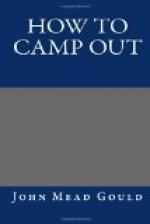In crossing a high narrow foot-path, never look lower than your feet; the muscles will work true if not confused with faltering instructions from a giddy brain. On soft ground see what, if any thing, has preceded you; large hoof-marks generally mean that the way is safe: if none are found, inquire for yourself before going on. Quicksand is the most treacherous because far more dangerous than it looks; but I have seen a mule’s ears finally disappear in genuine mud.
Cattle-paths, however erratic, commonly prove the surest way out of a difficult place, whether of uncertain footing or dense undergrowth.
“TAKING COLD.”
This vague “household word” indicates one or more of a long varied train of unpleasant affections nearly always traceable to one or the other of only two causes,—sudden change of temperature, and unequal distribution of temperature. No extremes of heat or cold can alone affect this result: persons frozen to death do not “take cold” during the process. But if a part of the body be rapidly cooled, as by evaporation from a wet article of clothing, or by sitting in a draught of air, the rest of the body remaining at an ordinary temperature; or if the temperature of the whole be suddenly changed by going out into the cold, or especially by coming into a warm room,—there is much liability of trouble.
There is an old saying,—
“When the air comes
through a hole,
Say your prayers to save your soul.”
And I should think almost any one could get a “cold” with a spoonful of water on the wrist held to a key-hole. Singular as it may seem, sudden warming when cold is more dangerous than the reverse: every one has noticed how soon the handkerchief is required on entering a heated room on a cold day. Frost-bite is an extreme illustration of this. As the Irishman said on picking himself up, it was not the fall, but stopping so quickly, that hurt him: it is not the lowering of the temperature to freezing point, but its subsequent elevation, that devitalizes the tissue. This is why rubbing with snow, or bathing in cold water, is required to restore safely a frozen part: the arrested circulation must be very gradually re-established, or inflammation, perhaps mortification, ensues.
General precautions against taking cold are almost self-evident in this light. There is ordinarily little if any danger to be apprehended from wet clothes, so long as exercise is kept up; for the “glow” about compensates for the extra cooling by evaporation. Nor is a complete drenching more likely to be injurious than wetting of one part. But never sit still wet, and in changing rub the body dry. There is a general tendency, springing from fatigue, indolence, or indifference, to neglect damp feet,—that is to say, to dry them by the fire; but this process is tedious and uncertain. I would say especially, “Off with muddy boots and sodden socks at once:” dry stockings and slippers after a hunt may make just




